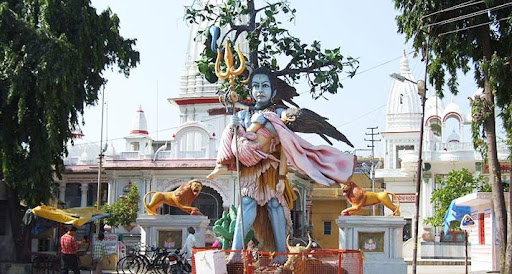Temples of Mahānirvaṇi Akhāḍā
Daksha Mahadev Temple Haridwar

Haridwar in North India is one of the most ancient cities in the world. Its original name was Mayapuri and it is mentioned in all our ancient scriptures – the Vedas and Puranas. It is the world famous pilgrimage center and gateway to the devbhoomi (the land of the gods)—Uttarakhand. It is a city of temples. There are innumerable places here which bear the footprints of one God or the other and which have been hallowed by their lilas (divine life incidents) and later on their temples were built to consecrate their divine memories which radiate the energy of superconsciousness that they carried. The most famous temple of this holy city, is the Daksheshwar Mahadev Temple in Kankhal, about 6 kms from Har-Ki-Pauri (where the grand sacred flame offering to river Ganga happens every evening), at the southern periphery of the city. It is said that this spot is the source of all the 52 shakti peethas (centres of divine feminine energy) in the world.
History of Daksha: The genesis of the temple lies in the Puranic history narrated in the Shiva Purana. As answer to the prayer of Brahma for the Creation energy to descend, who is one of the trinity of the Hindu gods that is Paramasiva, Brahma and Vishnu, Jagdamba or Bhagavati (the supreme feminine divine energy) took birth as Sati. She was born in the form of the daughter to Brahma’s son – Daksha Prajapati who had his kingdom at Kankhal in Haridwar, North India. Sati performed hard and long tapasya (penance) to please Lord Paramashiva to wed her. At last, the Lord consented to marry her. However, King Daksha was not in favour of the marriage and remained aloof in the relationship. Shiv Purana narrates how King Daksha organized a big yajna (sacrificial fire ritual) at Kankhal and invited all the Gods, Rishis and Munis to the ritual, but deliberately avoided calling Sati to it. When Sati came to know of the yajna, even though cautioned by Paramasiva, she prevailed on Him to allow her to go for it.
During the yajna, Daksha uttered insulting words towards Paramasiva to Sati in front of the large congregation. Sati, unable to bear the humiliation, consigned herself to the flames of the yajna. As the tragic news reached Paramasiva, he sent Veerbhadra, a fierce extension of Himself, to Kankhal. Veerabhadra took the head of King Daksha and annihilated it in the fire of the yajna. King Daksha fell low in the eyes of all. King Daksha repented his deep arrogance and misdeeds. From the sacrificial fire rose Parabrahman, a personified form of the formless Supreme Almighty and told Daksha that Paramashiva is the Pramabrahman in form. Daksha understood his folly and repented for it.
On the request of all the Gods who were watching including Lord Vishnu, Paramashiva appeared there in the form of a Shivalinga. The benevolent Paramasiva in order to complete the yajna that had been disrupted, restored King Daksha to life by attaching the head of a male goat on the shoulders of his corpse. Paramasiva declared that every year during the month of Sayan when this incident took place, the month that is dearest to the Lord, Kankhal would be His abode. After this, the grief-stricken Lord Paramasiva wandered across the universe, carrying the dead body of his consort Sati.
Lord Vishnu, with his Sudarshan Chakra (divine disk-like weapon that he bears in his right rear hand), and slayed the parts of Sati’s dead body in order to separate it from Lord Paramashiva and free him from his deep mourning. The places where the severed parts of Sati’s body fell on the earth later on became shakti peethas (Seats of pure divine feminine energy) and came to be revered. Temples came up at the place at Kankhal where this epochal event unfolded itself.
Later on in 1810, the king of Landhaura State in Haridwar, who had the legal rights on the land, constructed a big temple here. This temple, the Daksheshwar temple, was renovated in 1963 by the Mahanirvani Akharas Kankhal, which now looks after the management of the temple. The Daksheshwar Temple, along with a few other temples in the precinct, such as the Hanuman Temple, the Dasham Vidya Temple etc stand on the serene banks of a tributary of the sacred Ganga river at the foothills of the Shivalik Ranges.
One part of the Temple consists of the Yajna Kunda (the sacrificial fire pit of Daksha), while in the other part, a Shiva Linga has been installed (symbolising the appearance of Paramasiva as a Shivalinga), which is worshipped by devotees by the offering of water to it. The entire story of the yajna of King Daksha and the episodes have been vividly depicted on the walls of the temple. An ancient sacred banyan tree, said to be thousands of years old, is also the cynosure of all the eyes in the precincts of the temple.

The Daksha Mahadev temple in Haridwar where the Daksha Yajna happened. Paramasiva is seen carrying the dead body of Sati His Divine Consort
https://www.haridwartravelagents.com/daksha-mahadev-temple-haridwar.html
The temple lures lakhs of devotees from the country and abroad, around the year. However, there is a heavy rush of Lord Paramashiva’s devotees in Vedic month of Shravan (Jul-Aug). On Shivratri (a festival dedicated to Paramasiva), a large number of devotees congregate here to pay obeisance to the Lord and seek His blessings and benediction.
